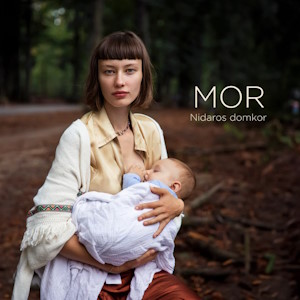
MOR
Petra Bjørkhaug (b. 1964)/Ragnhild Jepsen (b. 1969)
Sårmerkt
Domenico Scarlatti (1685-1757)
Stabat Mater
Ditte Marie Bræin (soprano), Martin Vanberg (tenor), Anna Carlsen (cello), Petra Bjørkhaug (organ)
Nidaros domkor (Nidaros Cathedral Choir)/Karen Haugom Olsen
rec. 2021/2022, Nidaros Cathedral, Trondheim, Norway
2L 2L176SABD SACD/BD-A [50]
MOR, or mother, is one of those combined programmes that take a moment or two to find out what is going on. But the beauty of musical content, quality of performance and recording royally reward all questions and time spent. Composer Petra Bjørkhaug has worked in and around Norwegian churches and cathedrals for many years as organist and choral conductor. She has been Cathedral Organist at Nidaros Cathedral since 2007. Texts are by Ragnhild Jepsen, a Norwegian priest and provost in Nidaros Cathedral who was made a Bishop in 2023.
This programme combines Petra Bjørkhaug and Ragnhild Jepsen’s Sårmerkt with Domenico Scarlatti’s Stabat Mater. Sårmerkt translates as ‘Wounded’, and the Stabat Mater of course deals with Mary’s mournful suffering as Jesus’s mother during his crucifixion. Bjørkhaug’s music can be performed separately, but she writes: “I wanted to find a musical language that could both correspond to and contrast with Scarlatti’s music. The work is composed as a commentary on the Stabat Mater… [and] it is hoped that the choral compositions can be experienced as redemptive for the context of the texts, and that they can provide a space for reflection and contemplation.”
Bjørkhaug as organist mentions Olivier Messiaen as an influence but the tonal qualities of the new music here are, with the addition of some nicely juicy harmonies, much more ‘old’ church in character than anything avant-garde. Clarity of communication with the texts is important, as is a lyrical and harmonic connection with their message. A fair portion of the words are quotes from various sections of the Bible. There is a nice blend between a capella settings and movements with organ. The cello adds colour and expressive depth to Scarlatti’s music. Solo vocal parts add emphasis to the choral sonorities with a predominance of female voices, as one might expect.
It is tempting to select the tracks of Sårmerkt alone to see how that works, but some of the most moving transitions are between the new and the old. Try that from track 5, Til hendene to 6, Quis non posset, and you will hear what I mean. The opening out from close harmony to Scarlatti’s cadential phrases is one of those juxtapositions that cast a sublime spell. This is a recording with a more sacred than secular atmosphere, but there is nothing at all wrong with that. In purely abstract terms, on blind hearing one might not immediately think of motherhood with this programme. Yet, the cover photo and blurb soon point us in the right direction: “Which mother do you think of? A loving mother with a newborn baby in her arms. Intimacy. A despairing mother in deep grief over a lost life. Emptiness.”
Beautifully performed and recorded, this is the kind of release that will always have universal relevance. I would urge listeners to follow the texts for its utterly moving sentiments to take full effect.
Dominy Clements
Buying this recording via a link below generates revenue for MWI, which helps the site remain free.



Contents
Mariavise
Stabat Mater: Stabat Mater dolorosa
Sårmerkt: Til knea
Stabat Mater: Cujus animam gementem
Sårmerkt: Til hendene
Stabat Mater: Quis non posset
Sårmerkt: Til sidene
Stabat Mater: Eia Mater, fons amoris
Sårmerkt: Til hjartet
Stabat Mater: Sancta Mater
Sårmerkt: Til hjartet (salme)
Stabat Mater: Fac me vere
Sårmerkt: Til andletet
Stabat Mater: Iuxta crucem tecum stare
Sårmerkt: Til brystet
Stabat Mater: Inflammatus et accensus
Stabat Mater: Fac ut animae
Sårmerkt: Til føtene
Stabat Mater: Amen
Tota pulchra es

















